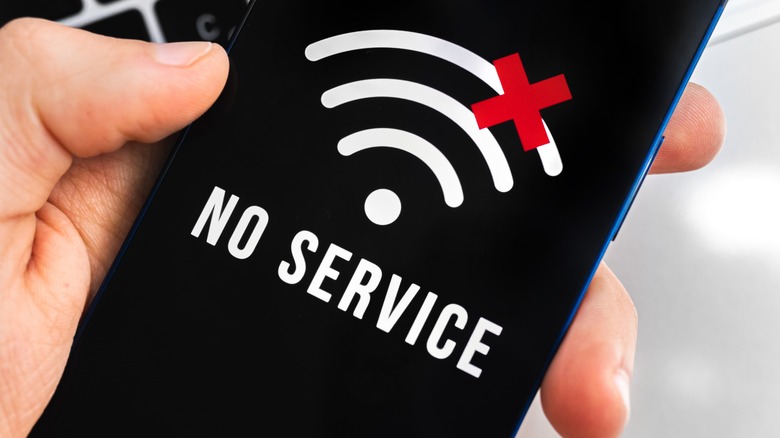The Reason Why Some Cellphone Providers Are Worse Than Others
Picking out a phone is one thing: Do you want a nice, attractive iPhone? Perhaps a cool folding Samsung phone, or an affordable Google one? You probably know what you want before considering what carrier you'll use.
The question is, how do you pick a service provider for your chosen device? The Big Four have been reduced to The Big Three (Verizon, AT&T, and T-Mobile), but with smaller online-only providers like Mint or Visible, you have more choices than before.
You might have heard your friends or family say that this provider is good, but this one stinks. Maybe you had a completely different experience. What is it about some providers that make them worse than others? It depends on a few factors, as various providers will work better in different situations, especially when it comes to location.
Spotty coverage will make you miserable
The number one thing that's going to make your cell service a frustrating mess is coverage. Back in the day, carriers had commercials that touted how big their networks were. Now, that's less common, but checking out coverage before signing up is essential, even if you live in a suburb or city. One provider could have a big dead spot in the center of town, while another doesn't.
Nearly all providers in the U.S. use cell towers powered by one of the Big Three, so checking the coverage maps for Verizon, AT&T, or T-Mobile is a must. If you're using a smaller carrier, find out whose towers they use, then check out the appropriate map. You may be surprised by what you find if you zoom in far enough.
It used to be the case that U.S. carriers were split between two competing technologies, GSM and CDMA, but these aren't important anymore because they were only used for 2G and 3G networks, which are being phased out (per PCMag). Some people felt one worked better than the other, but all the major carriers now use a single standard, just different frequencies within that standard. In theory, they should all operate more or less the same in areas with similar levels of coverage.
Data prioritization is the bane of low-cost carriers
If you've looked into low-cost carriers, you might have seen "reduced priority" mentioned. What is that, exactly, and how can it worsen your experience?
Smaller carriers typically don't have their own towers. Instead, they use towers from one of the Big Three: Mint, for example, uses T-Mobile towers. Visible uses Verizon. Cricket uses AT&T. These carriers are called mobile virtual network operators, or MVNOs. They purchase bandwidth from one of the Big Three for cheap, but there is a trade-off: This data is often served at a lower priority. Let's say an MVNO purchased data from T-Mobile. This data is cheaper than the data T-Mobile provides for its own customers, but it's given a lower priority on the network. T-Mobile serves its own customers first.
This means in crowded areas you may have full bars, but your connection is very slow, or you may be unable to access the internet (per Android Central). This is because the people around you, assuming they get service directly from one of the Big Three, get first dibs on bandwidth. This will make the most significant difference in big cities, but it can affect you anywhere where there's many people, like airports, events, or even busy shopping areas. In extreme cases, your $15 monthly data plan may not work at all once you're around too many others.
Customer service is key to a good provider
If you've never had problems with your mobile phone service, consider yourself lucky. Wireless communication is some complicated tech, and things are bound to go wrong at one point or another. The quality of its customer service can make or break your experience with a provider when things get messed up.
This can vary a bit depending on your situation. For example, if you have multiple lines or a more expensive plan, you might get better service than you would otherwise. On a fundamental level, some providers just don't have good customer service, and your location or plan typically won't matter.
Several groups do rankings of cell providers every year. J.D. Power, the American Customer Satisfaction Index, and Consumer Reports are just a few of the bigger ones out there. It does pay to look into a provider's customer service before you commit to them, as this is a critical area that determines whether or not you'll have a bad experience.



